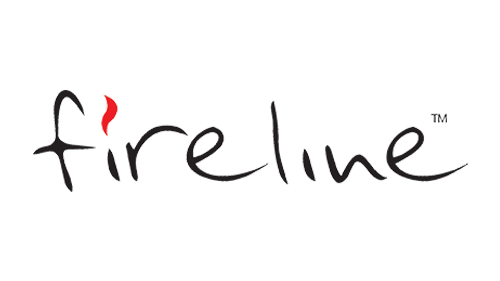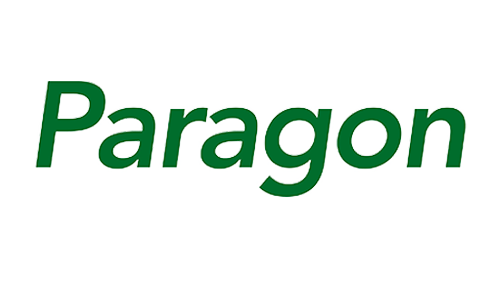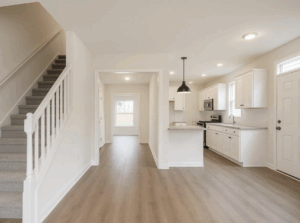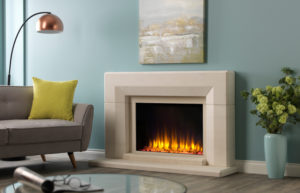For ultimate heating efficiency, it’s essential that you 1. Use a highly efficient Ecodesign stove, 2. Burn the right type of correctly seasoned wood, and 3. Operate your stove and it’s controls as intended.
When these three elements work together, they create the perfect setup for clean, effective heat. However, fully understanding and applying each of these factors is crucial to ensure you’re getting the very highest possible efficiency from your stove. Unless you’re an expert-level stove user, you may not be hitting all these points perfectly.
Here, we examine the two key points to consider after purchasing an ecodesign stove for optimal burn performance.
It’s what you burn and how you burn it!
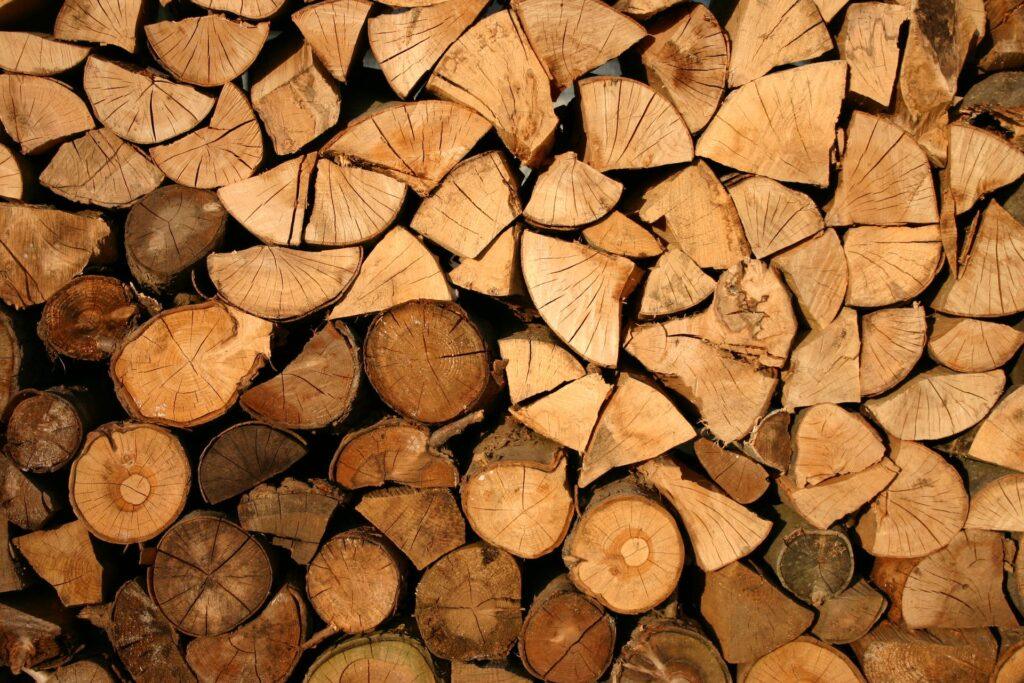
1. What You Burn:
We have spoken about this at length, and for good reason. Choosing the right fuel is the foundation for cleaner combustion. The fuel you burn, particularly its moisture content and quality, significantly impacts emissions and efficiency.
Use dry, seasoned wood: Burn only seasoned or kiln-dried logs with a moisture content of 20% or below. Wet or unseasoned wood produces excessive smoke, harmful particulates, and tar, while also wasting heat energy. Much of the fire’s heat goes into evaporating water. In contrast, dry wood provides more heat and far less smoke. A government-backed certification that we fully support, called “Ready to Burn”, labels wood fuel that has been dried to the required 20% moisture level. Whenever buying firewood, look for the Ready to Burn logo as a guarantee of good-quality dry wood. Since 2021, UK regulations have phased out the sale of small volumes of wet (unseasoned) logs, so reputable suppliers now provide only dry wood in bags or crates.
The illustration below illustrates the significant impact of moisture levels on the heat output of firewood. Also, bear in mind that having overly dry wood can cause the wood to burn too hot and too quickly, and it could damage your stove. The lowest recommended percentage moisture content of firewood is around 12 to 15%. Closer to or around 20% is preferred.
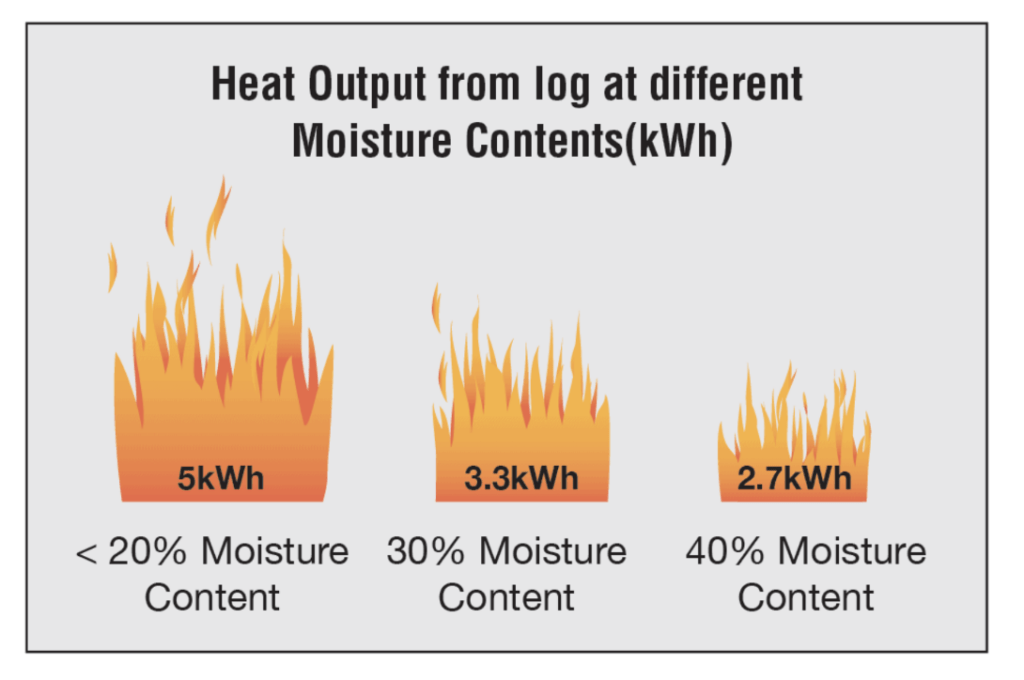
Choose appropriate wood types: Any untreated wood can burn cleanly if dry, but dense hardwood logs (e.g. oak, beech, ash) generally provide a longer, hotter burn with less resin than softwoods. Use only untreated, natural wood. Never burn wood that is painted, stained, or chemically treated, such as old furniture, pallets, or MDF, as these materials release toxic pollutants and heavy smoke when burned. For the same reason, do not burn household rubbish or plastics in your stove. Stick to clean wood or approved smokeless fuels only.
Season and store wood properly: If you harvest or buy “green” wood in bulk (e.g. logs from tree work or volumes >2 m³), air-dry (season) the wood for at least 18–24 months before use. Store firewood in a dry, well-ventilated area such as a log store that keeps rain off but allows airflow through the stack. Splitting logs into smaller pieces also helps them dry more quickly. It’s wise to use a moisture meter to check that your logs have a moisture content of around 20% or less before burning. Properly seasoned wood not only lowers emissions but also protects your stove and chimney from soot and creosote buildup caused by smouldering wet fuel.
By selecting clean, dry wood, stove owners are on the road to efficient combustion. Burning high-quality fuel not only cuts pollution but often saves money too, since dry wood provides more heat per log, meaning you burn less fuel for the same warmth.
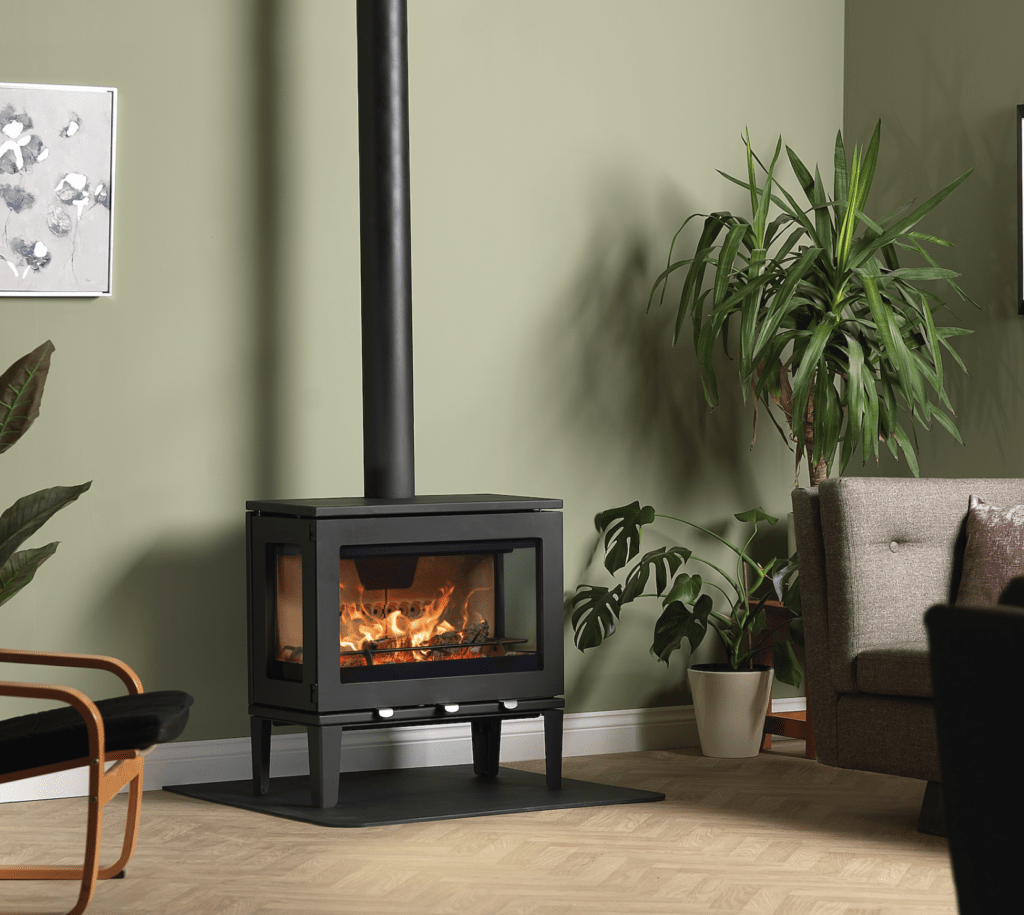
2. How You Burn It:
How you burn the wood is just as critical as what you burn. Even with an Ecodesign stove and dry fuel, poor burning techniques can lead to smoky, inefficient fires. Stove owners should consider the following burning techniques and stove operating practices to minimise smoke and maximise heat:
Light the fire correctly: Always start a fire with plenty of small, dry kindling and/or an appropriate firelighter. The goal is to get the fire hot quickly. A fast, hot ignition causes the stove and flue to warm up, improving the draft and combustion efficiency. One recommended method is the “top-down” lighting technique, where the largest logs are placed at the bottom and kindling on top, so the fire burns downward.
This warms the chimney faster and avoids the need to open the stove door to add fuel to lit kindling, which can cool the chamber and release smoke into the room. In all cases, fully open the air vents when lighting to supply lots of oxygen, then ignite the fire and close the stove door to let the chamber heat up quickly. For the first 5–10 minutes, burn the fire briskly; a new stove load needs time to reach proper operating temperature.
Maintain a hot, efficient burn: Once the fire is established, adjust the air controls to sustain a bright, steady flame – but do not “slumber” the stove by shutting the air vents too far. Slumbering, running the stove with very low air supply, e.g. overnight, leads to incomplete combustion, causing a smoky fire that wastes fuel and creates tar deposits in the flue. Instead, aim to burn “hot and clean”: keep the fire in the ideal temperature range. Using a simple flue pipe thermometer can help monitor this, many stove owners use these gauges to know when the stove is up to optimal temperature and to avoid letting it drop too low.
The adage is “burn it hot to burn it all” – a hotter fire will combust more of the wood’s gases and particles, resulting in more heat for you and less smoke out the chimney. In practice, this means adding logs in moderation, small to medium-sized logs burn more completely than very large logs, and adjusting airflow so that flames remain lively. The stove glass should stay mostly clear, not sooting up immediately.
Refuel in small, frequent batches: Don’t overload the firebox with too many logs at once, which can choke the flames. It’s better to add one or two logs at a time when the fire has burned down to embers, and then open the air vent for a few minutes to help the new fuel ignite cleanly. When opening the stove door to refuel, do so slowly and only when needed, this prevents smoke from spilling into your room.
A properly functioning stove should not emit smoke back into the room during refueling; if you frequently see smoke spurt out when adding logs, something may be wrong with draft or technique, consider getting professional advice in that case. Always latch the door closed after refueling; an open door lowers the combustion temperature and lets unburned smoke escape up the chimney instead of burning in the fire.
Ensure adequate air supply and ventilation: Modern stoves are designed to burn wood efficiently with controlled air, so make sure air inlets are not blocked and that your room has enough ventilation. All stoves require a good supply of fresh air to maintain the draft, in some homes (especially air-tight modern houses) an external air vent or slightly open window may be needed to feed the stove sufficient oxygen.
A strong flue draft pulls air through the stove and carries away smoke, so keeping the flue warm (as noted, by burning actively) and ensuring vents are appropriately open will help expel pollutants out the chimney rather than into your home. If the stove is starved of air, combustion efficiency plummets and pollution rises sharply. Learn more specifically about chimneys here.
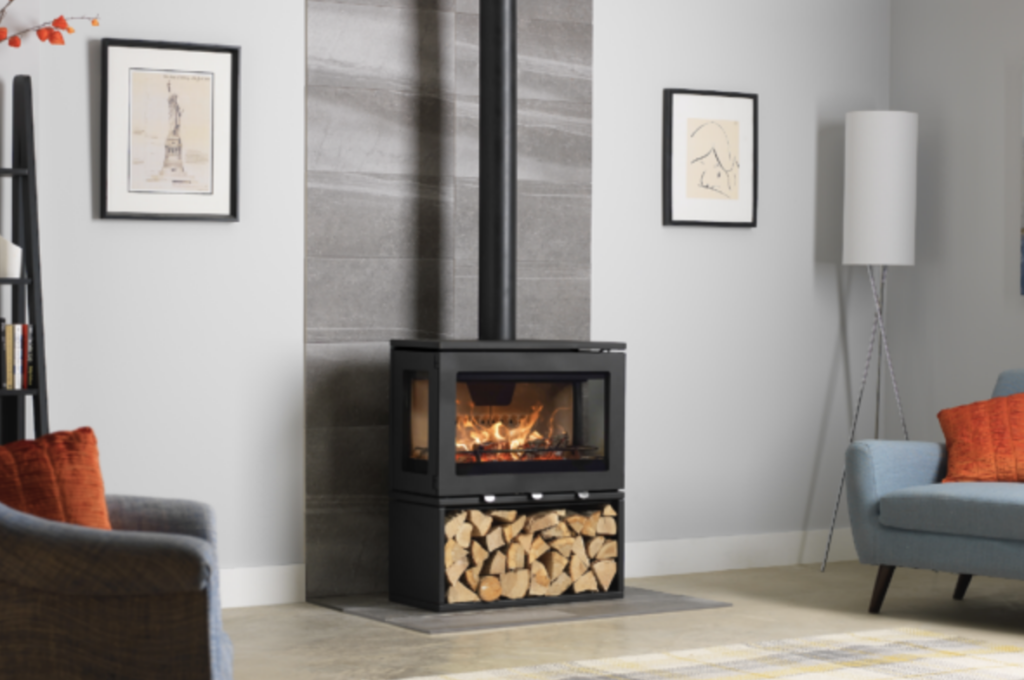
Monitor your chimney’s smoke as a guide: A quick visual check outside can tell you how cleanly you’re burning. After the initial lighting phase, a well-operated stove should produce little to no visible smoke from the chimney, you may just see heat haze. If you observe a steady stream of grey or white smoke from your flue except right after lighting or refueling, it’s a sign you need to adjust your burning practices. More air, drier wood, or a hotter fire may be needed.
Aim for a hot fire that makes transparent or nearly invisible exhaust, this indicates more complete combustion of the wood’s particulates. Not only does this minimise neighborhood air pollution, it also indicates you’re getting the most heat out of your fuel.
By following these techniques – using ample kindling, keeping fires hot, not damping them down excessively, and watching for smoke, stove users can further cut emissions. Research shows that user behavior makes a big difference: one study of emissions data found that Ecodesign stoves contribute only a tiny fraction of PM₂.₅ pollution (around 0.3%) when run on dry wood with good technique, whereas the same stoves can pollute far more if used improperly or with wet fuel.
Part of learning how to use your stove is knowing how to also keep it clean. For more specific information on cleaning a stove please click here.





